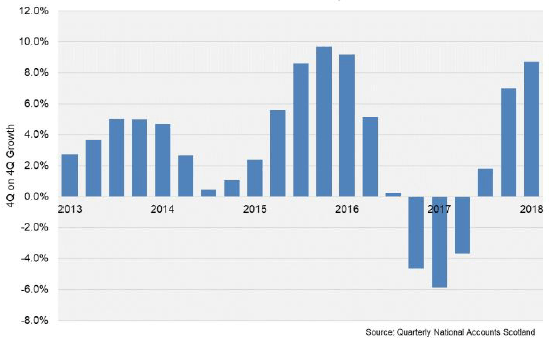State of the economy: October 2018
Report produced tri-annually by the Chief Economic Adviser to provide a picture of the Scottish economy in an international context.
This document is part of a collection
Scotland Manufactured Exports
Manufactured exports - which make up around half of the total value of international exports from Scotland’s onshore economy - increased by 3.6% in Q1 2018 and by 8.7% on a rolling annual basis.
The increase in the volume of manufactured exports was relatively broad based with growth across the three largest exporting sectors of food and drink, engineering products and refined petroleum, chemical and pharmaceutical products.
Scotland Manudactured Exports

More recent data from HMRC, show that Scotland’s international goods exports (including oil and gas) increased in cash terms by 7% (£1.9 billion) to £28.8 billion over the year to June 2018, compared to the previous year. This increase was driven, in part, by a rise in oil and gas exports to the EU, which increased by 29% (£1.6 billion) to £7.0 billion on the back of rising energy prices. However, even when oil and gas exports are excluded, total onshore goods exports also grew by 6% over the same period.
Alongside this, the North Sea oil and gas sector has continued to strengthen. Latest survey data from contractors in the sector report increasing levels of business confidence and activity into 2018, with further increases expected in the year ahead[1]. By supporting activity in the wider supply chain, this increase in activity directly boosts output in the production and manufacturing sectors in Scotland and feeds through to the wider economy.
The rise in the oil price to over $80 in October – representing an almost 30% increase since the start of the year – has further supported confidence and activity in the sector, however conditions throughout the industry supply chain remain challenging[2].
Recent revisions to Construction Sector and impacts on GDP growth.
The Quarterly National Accounts Scotland (QNAS) publication in August 2018 contained revisions to GDP growth in the construction sector that has impacted on the recent GDP growth time series profile.
Previously, the construction sector was estimated to have grown very quickly in 2014 and 2015 before falling in subsequent years. Whilst this trend is still evident in the data, the industry’s growth is now estimated to have been less volatile.
| 2014 | 2015 | 2016 | 2017 | ||
|---|---|---|---|---|---|
| Scotland’s Construction Sector Output Growth | Previous estimate | 3.6% | 18.3% | -0.6% | -3.8% |
| Updated estimate | 0.2% | 6.2% | 1.6% | 4.3% | |
| Scotland’s GDP Growth | Previous estimate | 2.7% | 1.7% | 0.2% | 0.8% |
| Updated estimate | 1.9% | 0.6% | 0.4% | 1.3% |
The revisions to construction GDP reflect two new developments.
Firstly, new data on the historic output from the construction sector, which were published in July, have been incorporated into the estimates. This provides more detailed and accurate Scottish data for the construction industry, but are only available with a 2-3 year lag.
Secondly, the methodology used to estimate construction output in more recent quarters has been revised to minimise the risk of future revisions. A wider variety of data sources are now being used to produce the short term estimates, rather than relying on a single data source.
Whilst revisions are always made to GDP as new data become available, the recent changes to construction were unusually large.
This is because the previous methodology appears to have under estimated the amount of construction activity in Scotland which was imported (i.e. completed by businesses not based in Scotland) or which was completed by businesses classified into other industries. Both of these factors are particularly important at present given the number of high value energy infrastructure projects, such as onshore and offshore windfarms, where some of the construction activity actually takes place overseas or using foreign contractors.
More information on the revisions made to the construction and GDP series are available in the latest QNAS publication on the Scottish Government website[3].
Contact
There is a problem
Thanks for your feedback